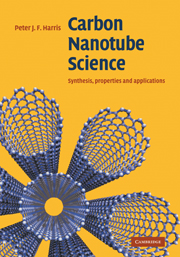Book contents
- Frontmatter
- Contents
- Preface
- 1 Introduction
- 2 Synthesis I: arc- and laser-vaporization, and heat treatment methods
- 3 Synthesis II: catalytic chemical vapour deposition and related methods
- 4 Purification and processing
- 5 Structure
- 6 Physical properties I: electronic
- 7 Physical properties II: mechanical, optical and thermal
- 8 Chemistry and biology of nanotubes
- 9 Carbon nanotube composites
- 10 Filled and heterogeneous nanotubes
- 11 Probes and sensors
- 12 Conclusions
- Name Index
- Subject Index
3 - Synthesis II: catalytic chemical vapour deposition and related methods
Published online by Cambridge University Press: 20 May 2010
- Frontmatter
- Contents
- Preface
- 1 Introduction
- 2 Synthesis I: arc- and laser-vaporization, and heat treatment methods
- 3 Synthesis II: catalytic chemical vapour deposition and related methods
- 4 Purification and processing
- 5 Structure
- 6 Physical properties I: electronic
- 7 Physical properties II: mechanical, optical and thermal
- 8 Chemistry and biology of nanotubes
- 9 Carbon nanotube composites
- 10 Filled and heterogeneous nanotubes
- 11 Probes and sensors
- 12 Conclusions
- Name Index
- Subject Index
Summary
The preparation of carbon nanotubes by catalysis has a number of potential advantages over the arc and laser methods discussed in the previous chapter. In particular, catalysis (or chemical vapour deposition, as the process is often called) is much more amenable to scale-up than arc- or laser-evaporation, and many successful processes for the large-scale catalytic synthesis of both SWNTs and MWNTs have been developed. Catalytic techniques also enable nanotube synthesis to be achieved under relatively mild conditions, giving more control over the growth process. Thus, it is possible, using catalytic methods, to grow arrays of aligned nanotubes on substrates. Such arrays are showing great promise as field-emission displays. It may also be possible to construct nano-electronic circuits by using catalysis to grow defined networks of nanotubes. It is widely believed that the main disadvantage of catalytic methods is that nanotubes produced in this way are structurally inferior to those made by the high-temperature arc and laser techniques. While this may still be true for multiwalled tubes, there is evidence that catalyticallyproduced SWNTs can have a high degree of structural perfection, as noted at the end of the last chapter. This may suggest that a common growth mechanism is involved.
The long history of filamentous carbon production by catalysis was outlined in Chapter 1. The present chapter begins with a brief summary of the work carried out in the 1970s and 1980s by Baker, Endo and others, but concentrates mainly on post-1991 research. Methods for growing aligned MWNTs on substrates, and for producing nanotube yarns are described. The structure and possible growth mechanisms of catalytically produced MWNTs are then discussed.
- Type
- Chapter
- Information
- Carbon Nanotube ScienceSynthesis, Properties and Applications, pp. 43 - 79Publisher: Cambridge University PressPrint publication year: 2009

